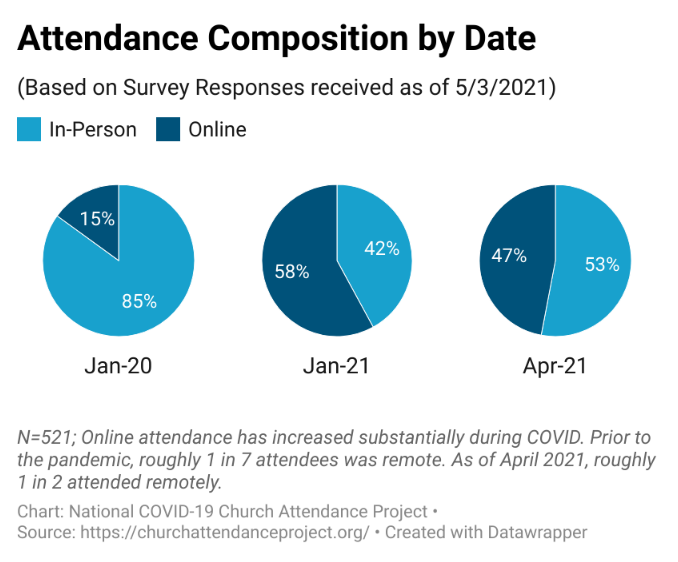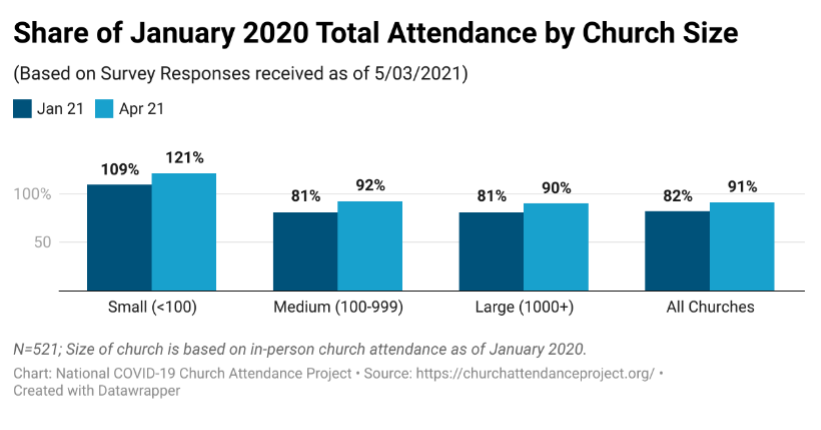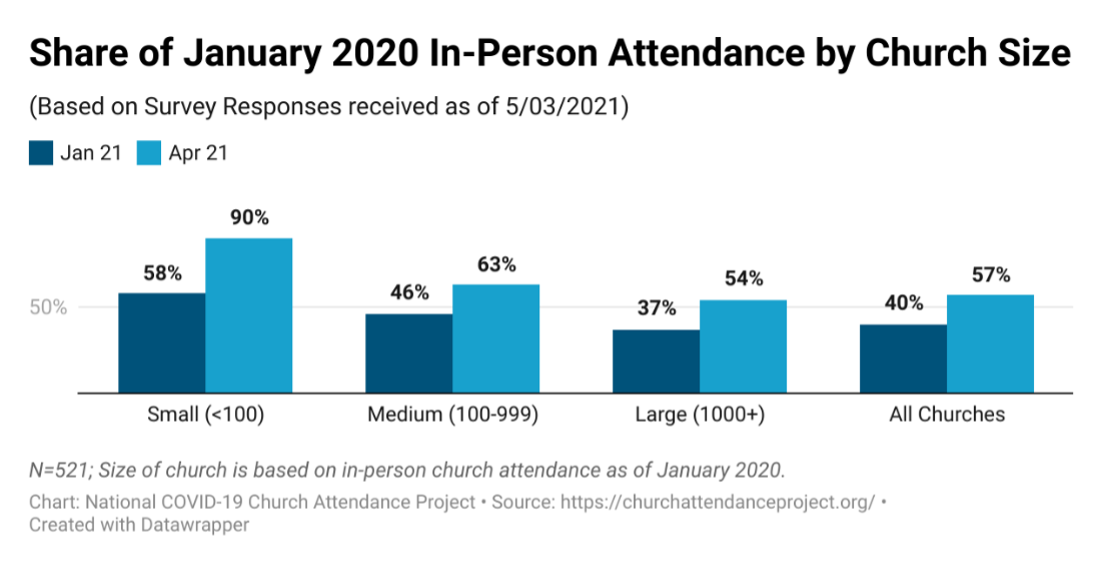“Are people going to return to church after COVID?” This question, on the minds of pastors everywhere, is at the heart of the National COVID-19 Church Attendance Project (NCCAP). Posed directly to one of us by his brother, a pastor himself, it served as the genesis for this project on church attendance patterns.
Most of us are aware of the effects of COVID-19 on our home church. Many of us have heard accounts of various other churches through conversations with friends and colleagues. But it is hard to know what these individual stories mean for the church as a whole.
The NCCAP represents our efforts to try to see the bigger picture. By gathering as many individual church stories as possible, from all over the country, we aim to provide a broad sense of the impact of COVID on attendance and what the path to recovery has looked like for churches so far. Through the collaboration of Wheaton College, Exponential, Outreach, and the Wheaton College Billy Graham Center, our initial survey represents the experience of more than 600 churches, over 400,000 weekly worshippers geographically covering 47 states and the District of Colombia.
We hope you will join us as we unpack our initial findings. In this article, we will provide an overview of our findings regarding church attendance patterns over the past year and a half. Our second article will reflect on church giving and staffing and our final installment of this three-part series will focus on church leadership and priorities at present and looking forward.
Church Attendance Patterns During the Pandemic
The disruption in church attendance patterns is astounding. The COVID-19 pandemic and ensuing policy responses resulted in significant and rapid changes in church attendance patterns.
As a macroeconomist who studies movements in aggregate variables, it is hard to underemphasize how unusual movements this large are. Among churches surveyed, in-person attendance has suffered dramatically. At the peak of COVID in January of 2021, in-person attendance had fallen by 60 percent compared to January of the preceding year. This means that for every 10 people attending in-person the prior year, only four were attending in-person in January of 2021.
The church has adapted. Churches have not been idle. Over the same period, we have observed church leaders actively respond through a substantial increase in online presence.

Throughout the last year, 96 percent of churches provided some form of remote option for their congregants. Online attendance has tripled.** Remote attendance represented the minority of weekly worshippers prior to the pandemic. In January of 2020, 1-in-7 weekend congregants were remote. A year later, almost 6-in-10 people were attending remotely. While we are praying for a safe and full return to church as normal when the time comes, it is worth taking a moment to appreciate the work that has been accomplished over the past year.
People have started to return to church. In January of 2021, in-person church attendance was a meager 40 percent of the preceding year. Just three months later that number had risen to 57 percent of the pre-pandemic crowd. Even better, much of this represents increased engagement by parishioners. While we have seen remote attendance begin to drop, the increase in physically present worshippers has more than offset the decrease.
In August of 2020, Thom Rainer predicted that roughly 20-30 percent of church members would not return to church after the pandemic. Thankfully, we have reason to believe that may have been pessimistic. Among churches surveyed, as of January 2021, combined in-person and remote attendance was just over 80 percent of pre-pandemic levels.

By April 2021, this had increased to 91 percent. Things are moving in the right direction, but we are certainly not out of the woods yet. The uptick for both in-person and total attendance in the last three months is encouraging. The coming months are critical for the post-COVID return and defining the new normal. We need to be encouraging people to come back to the church when the time is right.
Looking Ahead. We have just scratched the surface in our initial analysis. Going forward we hope to delve deeper into understanding more subtle relationships revealed by the data. For example, we have observed that small churches have experienced a smaller decline and faster recovery in terms of in-person attendance relative to their larger counterparts. Middle-sized churches had the smallest online presence (as a fraction of attenders) prior to the pandemic and have grown the most in this area.
By continuing to analyze the data, we hope to better understand how patterns have differed geographically and across denominations. Additionally, we want to understand how different policy requirements by governments and churches have led to disparate effects on attendance and engagement. To do so we need your help. If your church has not already done so, please join us. Understanding changes over time is critical. If you are already participating, we ask that you stay engaged by reporting attendance data monthly for six months. All participating churches have access to full reports and analysis.
Friedrich Hayek, a famous economist, identifies two types of knowledge. One type is scientific fact. Water freezes at 32 degrees. Always true. The second is knowledge of time and place. I am hungry right now. In North Carolina, there are gas shortages. Many important decisions hinge critically on this knowledge of time and place, but this type of knowledge is broadly distributed. Each of us holds a critical piece to the puzzle. We are better together. Through this project, we hope to connect the different pieces of understanding to leverage and communicate what is working and to avoid fruitless labor. Ultimately it is God who will bring people to his Church, but perhaps God will do so through our efforts to share our knowledge with one another.
**It is important to note that even as online access has rapidly increased due to COVID restrictions, there remains no established standard measurement for online attendance. Most pastors track the number of views directly (65 percent). Among churches that attempt to estimate the number of viewers rather than count the number of devices accessing the service, many smaller churches can directly count viewers. Among those applying a multiplier on views, there is a considerable variation with the most common multipliers being: 1.3, 1.5, 1.7, 2, 2.5. In our reporting, we divided all churches counting viewers by their multipliers to convert to a consistent number of views. Moreover, several churches noted their requirement of a minimum amount of time watched to contribute towards attendance. Again, this was not standardized. As online services continue to be widespread even as reopening gains momentum. We encourage denomination, network, and institution leaders to consider how to establish clear standards for tracking attendance to avoid unintentional disparities in reporting.
Enoch Hill is an Associate Professor of Economics at Wheaton College. He is a founding member of the National COVID-19 Church Attendance Project and holds a Ph.D. in Economics from the University of Minnesota.
Jason Long is the George F. Bennett Professor of Economics and the chair of the Department of Business and Economics at Wheaton College. He holds a B.A. in economics from Wheaton College and a Ph.D. in economics from Northwestern University. Professor Long’s research and teaching focus is on economic history, with a particular emphasis on social mobility, migration, and long-run economic growth. His research has been published in the American Economic Review, the Economic Journal, the Journal of Economic History, and the European Review of Economic History.
Cole Serfass is an FPE Scholar through the Center for Faith Politics and Economics at Wheaton College. He is studying Computer Science and Business Economics.


